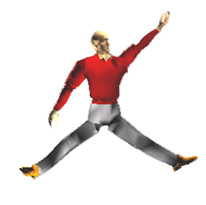| Quick Links | . |
|---|---|
|
Project Description By
|
. |
| CS184
Final Project:
Hierarchical Modeling, Manipulation and Animation of Human Body |
| By Yitao Duan
(cs184-bj ) duan@newton.me.berkeley.edu
Johnny Chang (cs184-db) jtc@uclink4.berkeley.edu Project Description
As part of an ongoing project which simulates human thermal comforts, it is critical to obtain a good geometric model of a human body, not only for visualization but also for accurate computing of radiant factors among body parts and the environment. It is also desirable if the model can be easily modified, so different gestures can be simulated. Currently the geometric model of body is generated outside the simulation program and is composed of a large number of fine, independent polygons. While it is adequate for one configuration, it lacks the flexibility to accommodate other situations. The body parts cannot be moved individually, so it is frozen in one gesture. Goal The goal of this project is to improve the existing model and add more appealing graphic features. Although this project involves modeling, rendering, and animation, we will concentrate mainly on modeling. This project will mainly focus on hierarchical modeling, and surface blending. Anticipated tasks:
Difficulties Picking up the polygons belonging to one body part. Hopefully different color tag from the external program which generates the original model can be used to do this. Joining of different body parts presents another problem. Since all body parts themselves are a collection of polygons which lack information identifying their position relative to the part they belong to, they are more likely to be treated as a rigid body and apply transformation to them as a whole. As a result there may be a gap between two body parts when one of them is moved. Must come up with some kind of blending.
|
| By Johnny Chang (cs184-db) & Yitao Duan (cs184-bj) 12-9-1999 |
